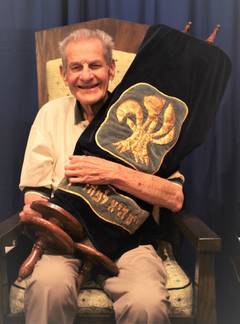- About Us
- Connect
- Learn
- Jewish Life
- Music
- Events
- Give
- Join Us
Shabbat
07/22/2019 01:44:47 PM
Liz Panken
| Author | |
| Date Added | |
| Automatically create summary | |
| Summary |
In Judaism, there is one holiday that occurs every week and this is Shabbat. It occurs on the seventh day of the week and is modeled after a biblical commandment: “ Six days you shall labor and do all your work, but the seventh day is a Sabbath of Adonai your God (Exodus 20:9-10). Shabbat is the only holiday mentioned in the Ten Commandments. Following the Jewish calendar, Shabbat begins at sunset Friday evening and continues through sunset on Saturday. Shabbat is reflective of our weekly cycle of work and rest. Rest does not mean sleeping, it implies taking oneself out of the ordinary routine, enabling us to restore our spirit and soul. Many Jewish calendars indicate the start time (to light candles) and the ending time.
So, why Shabbat? It occurs only when we make it happen!!
Some prepare special foods (Challah), eat special meals, light candles and chant special prayers such as the Kiddush. Some say how you set your table and prepare your meal should befit a visit by a queen. Shabbat is metaphorically seen as a queen. These activities and customs set Shabbat apart from being just another day.
Traditionally, Jews greet each other with special greetings on the Sabbath. Some say ‘Shabbat Shalom”, which translates to Shabbat peace, expressing the hope that you will have a peaceful Shabbat. I grew up with “Gut Shabbos” which is Yiddish for “Have a good Sabbath”. This is common among people of Ashkenazi descent.
When you light candles, this action ushers in Shabbat. Jewish customs requires a minimum of 2 candles because the fourth of the Ten Commandments occurs in two separate sections of Torah ( Remember the Sabbath day to keep it holy. Exodus 20:8-11 and Observe the Sabbath day to keep it holy. Deuteronomy 5:12-15). You may use more than 2 candles. Traditionally, they are white, but color may be used. The candles should burn for a substantial length of time. Jewish tradition has the woman of the household light the Shabbat candles. But, since the lighting is a requirement of Shabbat observance, it is not tied to gender. So… men can light also.
There are many other customs to explore to enhance your Shabbat experience. Some of these customs are: reciting the Kiddush (we do this at Temple on Fridays and Saturdays with the B’nai Mitzvahs), Donating Tzedakah which places the obligation on all of us to right the injustices of society by donating to groups in need, having challah at your dinner table and reciting the prayer (Motzi), Blessing our children on Shabbat ( based on the biblical story of Joseph and his sons), and practicing the ceremony of Havdalah (Marking the conclusion of Shabbat).
Celebrating Shabbat with our community in the sanctuary at Temple Israel reaffirms our ties to God and to each other. The service schedule is noted online at the temple website. The style of worship varies. Some services open the Torah, others are Multigenerational for those families with younger children and the need to worship earlier. Some services have a guest speaker, while others include a community Shabbat dinner. There are multiple choices for all in our community to engage.
Many families choose to “unplug” and stop all electronic devices, spend time together doing an activity such as enjoying nature, leisurely walks, hiking, reading together and resting. Maybe fitting in a nap! Explore for your family. I encourage all to go to Reform Judaisim.org and learn about the various customs of Shabbat.
B’Shalom,
Liz Panken
Ritual Committee Member
Fri, April 18 2025
20 Nisan 5785
Temple israel Happenings
-
Wednesday ,
AprApril 23 , 2025 Yom HaShoah Candle Lighting on Zoom
Yom HaShoah Candle Lighting on Zoom
Wednesday, Apr 23rd 6:30pm to 7:00pm
Rabbi Jaech and Laura Copel will lead a brief Yom HaShoah Candle Lighting Ceremony on Zoom. We invite you to join as you light your Yom HaShoah candle in at home. -
Thursday ,
AprApril 24 , 2025 County-Wide Yom HaShoah Commemoration
County-Wide Yom HaShoah Commemoration
Thursday, Apr 24th 12:00pm to 1:00pm
County-Wide Yom HaShoah Commemoration at the Garden of Remembrance, 119 Martine Avenue in White Plains. Temple Israel's rescued Holocaust Torah scroll will be part of the procession of scrolls from Westchester county, and Cantor Hayley Kobilinsky will participate in the program. -
Tuesday ,
AprApril 29 , 2025 Sisterhood Book Group
Sisterhood Book Group
Tuesday, Apr 29th 6:00pm to 8:30pm
NEW DATE! We will be discussing the book "The Frederick Sisters Are Living the Dream" by Jeannie Zusy in person at a congregants' home. The author will be joining us for the discussion. We will have a Pot Luck Dinner to start -
Wednesday ,
AprApril 30 , 2025 Holocaust Education Today: Challenges and Limits by Dr. Werner Steger
Holocaust Education Today: Challenges and Limits by Dr. Werner Steger
Wednesday, Apr 30th 6:00pm to 7:30pm
Dr. Steger serves as the endowed chair for the Greenspan-Handel Trust for Holocaust and Genocide Studies.
Events
Today's Calendar
| Chol Hamoed Passover |
: 7:00pm |
: 8:00pm |
Friday Night
: 7:00pm |
: 8:00pm |
Shabbat Day
: 9:30am |
: 11:00am |
Upcoming Programs & Events
Apr 19 |
Apr 23 |
Apr 24 |
Apr 24 |
Apr 29 |
Chol Hamoed Passover
| Friday, Apr 18 |




